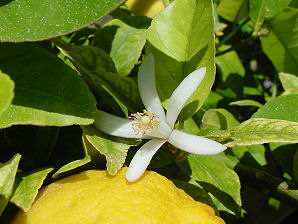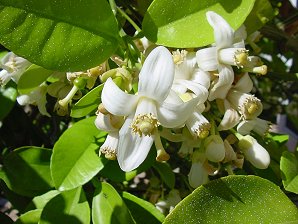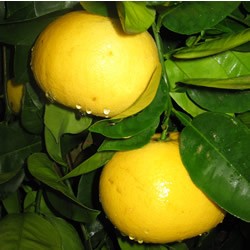Non - Xeriscape.
Common Landscape Plants. Shrubs, Flowers, & Trees.
For The Arizona Desert Environment
Pictures, Photos, Images,
Descriptions, & Reviews.
Citrus Trees. Citrus genus.
We Are Proud Of Our SafeSurf Rating!
 |
| Lemon Tree, In Glendale Arizona, March 21, 2003. |
|---|
 |  |
| Lemon Blossom. All Citrus Blooms About Same Time. March 15th - April 15th. | Lemon Blossom Lemon Trees Usually Bloom First! |
|---|---|
 |  |
| Naval Orange Blossom. Citrus Provides Large Amounts Of Nectar. Producing Great Quanities Of Honey. | Bees Gather Nectar From Base Of Flowers. Naval Orange Blossom. |
 |  |
| Lime Blossoms. | Grapefruit Blossom. Pure Citrus Honey Is Clear Like Water. It Takes On The Exact Flavor Of The Citrus It Comes From. |
 |  |
| Tangerine Tree. | Tangerine Blossoms. |
Citrus Trees.
We wish to thank Wikipedia, the free encyclopedia for some of the information on this page. We share images and information with Wikipedia. Citrus is a common term and genus (Citrus) of flowering plants in the rue family, Rutaceae. Citrus is believed to have originated in the part of Southeast Asia bordered by Northeastern India, Myanmar (Burma) and the Yunnan province of China. Citrus fruit has been cultivated in an ever-widening area since ancient times; the best-known examples are the oranges, lemons, grapefruit, and limes. From China, it was brought to India and then the Middle East and Europe at some point in time before the birth of Christ. It was then brought by Columbus to the Americas. Citrus Trees, Just about every yard in Yuma, Maricopa, Pinal and Mohave counties has one! While they are not native to Arizona, there are enough of these plants in our area that we are placing this page devoted to all citrus on our Plants Of Arizona Web Site. This page is not intended to give a completed discussion concerning citrus production, there are already many pages on that subject available on the internet. If you have specific concerns we do offer a book on citrus production through Amazon.com, available from a link on our web page. Citrus production in Arizona is basically limited to the areas in Yuma, Maricopa, Pinal and Mohave counties that are relatively frost-free, where sufficient inexpensive water is available. Land is sometimes taken out of citrus production and converted to cotton, grain or vegetable production because of the greater economic returns. Very high urban encroachment has also limited citrus production. The most economically damaging insect pest of Arizona citrus is called Citrus Thrips. On fruit, the citrus thrips punctures epidermal cells, leaving scabby, grayish or silvery scars on the rind.
The Texas citrus mite is also a common pest of citrus occurring throughout Arizona. This mite primarily feeds on the upper surface of leaves and is prevalent from February to May under cool temperatures, but will disappear with the onset of high temperatures. Feeding can cause leaf discoloration, and under high populations, they will often move to the fruit where feeding may result in rind scarring. If you look at the two photos of the Lemon Tree Blossoms, you will see evidence of this mite on the leaves. There are many other pests that can attack the Citrus Trees in Arizona and in other states. Citrus trees are typically propagated by growing a select variety on top of a rootstock variety. There are two reasons for doing this. The first reason is that a tree grown from a seed will not produce fruit that tastes like that of its mother or father tree. It is likely that it will be inferior, since select varieties are products of thousands of years of breeding. Also, a seedling tree would take much longer to start producing fruit. The second reason is that certain trees are better adapted to growing in certain types of soils. For example, a sweet orange tree would grow poorly in Arizona soil. So, rather than grow a sweet orange tree directly in the soil a grower takes a sour orange variety, which does well in this soil, and attaches a sweet orange variety to the top of it. Since the lower part of the tree ends up being the roots it is called a "rootstock". The best time to plant citrus trees in Arizona is in September, which gives them a good start for the next year. Citrus trees typically take 2 years after planting to start producing regardless of the size of the tree when planted. The amount of time is also dependant on the variety as well as how healthy the tree is. I do not recommend transplanting older trees.
Here are some links to the Nature Hills Nursery; where you can order some of their very high quality Citrus Trees. If you click, there is no obligation to buy! You will leave delange.org. NOTE: These are High Quality Speciality Trees. They are not usually found at the typical Big Box Stores!
Quick Notes:
Height: 15 - 20 feet with slightly less spread.
Flowers: Flowers are fragrant, White flowers.
Flowering Time: March - April.
Leaves: The leaves are simple, glossy green leaves.
Trunk: Up to 2 feet in diameter.
Soil pH requirements:
Sun Exposure:
Elevation: Can be found from 0 - 1,300 Feet.
Habitat: Orchards and landscaping.Found throughout Yuma, Maricopa, Pinal and Mohave Counties in Arizona.
Miscellaneous: Flowering Photos Taken; April 6, 2003. In Glendale, Arizona.
|



We Are Proud Of Our SafeSurf Rating!
Here Are Some Links To The Very Best & Most Popular Items Sold On Amazon.Com
To Learn More! Click The Links Below. No Obligation, Of Course!
| © 1966 - Present, Audrey, Eve, & George DeLange |




